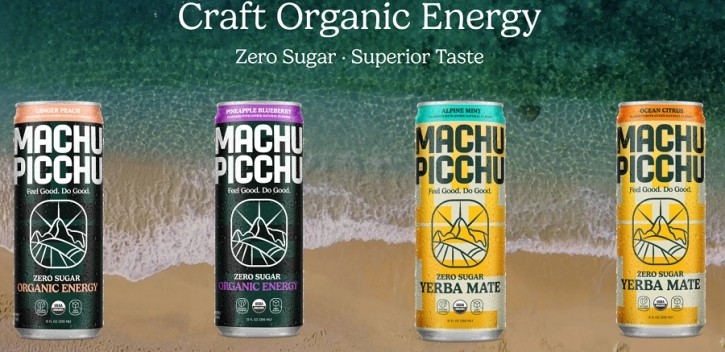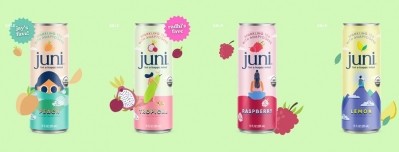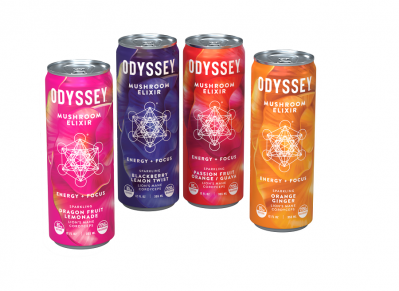Machu Picchu wants to clean up energy drinks from ingredients to marketing for broader appeal

In the market about a year, Machu Pichu’s collection of energy drinks were launched “for those who want Feel Good and Do Good energy,” which CEO Daniel Scharff told FoodNavigator-USA means using healthy ingredients that consumers can feel good about putting in their bodies and a strong social mission of helping children that they can get behind.
He explained when company founder Bernardo Paiva left his high-profile position as CEO of beverage giant Ambev SA he saw the energy drink segment was “on fire, but the quality of the liquids was very low” and didn’t align with consumer perceptions of the category or desire for healthy energy.
For example, research by the National Institute of Health estimates many leading energy drinks contain 21-34 g or more of sugar per serving, which Scharff notes many consumers want to limit. In addition, he said, many leading options use synthetic caffeine and artificial ingredients, while consumers want more natural options.
Likewise, he noted, much of the category’s marketing doesn’t align with many consumers values or goals.
“All of the main guys use this really cheesey marketing” centered on themes such as models and monster trucks, said Scharff, noting this doesn’t resonate with huge swaths of consumers or speak to why they want added energy.
“People are working more, they’re working out more, there is more of a hustle culture,” which is driving up demand for energy, but still many consumers would not consider themselves as “an energy drinker,” because they perceive these beverages as “some extreme thing” because of the marketing and ingredients typically used, said Scharff.
He added this “uncomfortable dissonance” is creating a “huge incremental opportunity in the category” that Machu Picchu wants to fill by offering a product that is both good for consumers and for the broader community and planet.
As such, he explained, “we set out to do offer the best tasting organic energy drink we could that would have natural caffeine instead of synthetic caffeine and organic ingredients and really build on our promise around going good by helping disadvantaged kids.”
[Editor’s note: Interested in learning more about the functional beverage set? Join FoodNavigator-USA Sept. 20 for our free webinar: Functional beverages AM to PM: From energy drinks and focus to clarity and calm. Get all the details and register.]
‘Bringing the good energy to people’
To meet consumer demand for natural, healthy energy drinks, Machu Picchu sources natural caffeine from organic green coffee beans and organic Peruvian maca, an adaptogen that the company says is “rich in key vitamins and minerals, such as vitamin C, copper and iron,” and which it sources through Imlak’esh Organics from the Andes Mountains.
The result is a “really good energy experience that is incremental to the category,” said Scharff.
The company also skips the high-fructose corn syrup, aspartame, preservatives and artificial colors and flavors used by the competition.
Instead it uses organic erythritol as a sweetener in its line of Zero Sugar Organic Energy and a combination of organic erythriol and stevia extract in its more recently launched line of Zero Sugar Yerba Mate. Both use fruit and vegetable juice for natural colors and combine organic green coffee caffeine and maca extract, and the Yerba Mate line also includes its namesake ingredient for added energy.
‘We didn’t want to create a niche product that would be an acquired taste’
The company also offers flavors that are simultaneously playful and familiar, like Pineapple Blueberry and Ginger Peach, which Scharff says will appeal to the mainstream. Likewise, flavors like Ocean Citrus and Alpine Mint add another dimension to the company’s tribute to outdoor enjoyment.
“We didn’t want to create a niche product that would be an acquired taste. But we wanted to bring the craft approach that was brought by beer that really drove tons of growth in that space to the energy drink market. We want to have a high-quality product that tastes great, is better than what is out there and is really drinkable and natural tasting,” he added.
‘The energy to do good’
Machu Picchu doesn’t just want to offer beverages that it says are healthier for consumers’ bodies, but it also wanted to offer consumers a message that is healthier for their emotional and metal wellbeing as well.
“Our company is called Machu Picchu because we want to bring outdoor inspiration to people’s lives. And so we try to remind consumers that while they may be working hard during the week, drinking our energy beverages at their computers, that they should also get out for a hike or get on the water during the weekend” and reconnect with nature to find a healthy balance of energy and restoration, Scharff said.
The company also wants consumers to use their energy – and buying power – to do good, which is why it donates at least 1% of its net revenue, as well as time and expertise, to causes that help children worldwide.
Among the groups with which Machu Picchu partners to help children are Alto Peru, Favela Radical, and UNESCO as a founding member and financial supporter of the 2030 Cultural Pact.
In the US, Machu Picchu fosters its “future competition” by teaching children in underserved public schools to create their own beverage companies through BevLaunch – an interactive workshop that teaches soft and technical skills associated with socially-conscious entrepreneurship, Scharff said.
He added that this is his favorite program because he is able to go into schools in Compton to teach children. But, he adds, the bigger dream is to release this fall a national online version of the curriculum.
Between the company’s social outreach, optimistic marketing focused on “true wellbeing” and better-for-you ingredients, Scharff said he believes that not only will Machu Picchu drive incremental growth in a category that is already “on fire” by appealing to a broader consumer base, but it also can drive change by inspiring consumers to drink change.








